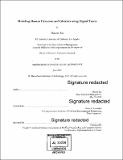Modeling human dynamics and lifestyles using digital traces
Author(s)
Xu, Sharon
DownloadFull printable version (8.752Mb)
Other Contributors
Massachusetts Institute of Technology. Operations Research Center.
Advisor
Marta C. González.
Terms of use
Metadata
Show full item recordAbstract
In this thesis, we present algorithms to model and identify shared patterns in human activity with respect to three applications. First, we propose a novel model to characterize the bursty dynamics found in human activity. This model couples excitation from past events with weekly periodicity and circadian rhythms, giving the first descriptive understanding of mechanisms underlying human behavior. The proposed model infers directly from event sequences both the transition rates between tasks as well as nonhomogeneous rates depending on daily and weekly cycles. We focus on credit card transactions to test the model, and find it performs well in prediction and is a good statistical fit for individuals. Second, using credit card transactions, we identify lifestyles in urban regions and add temporal context to behavioral patterns. We find that these lifestyles not only correspond to demographics, but also have a clear signal with one's social network. Third, we analyze household load profiles for segmentation based on energy consumption, focusing on capturing peak times and overall magnitude of consumption. We propose novel metrics to measure the representative accuracy of centroids, and propose a method that outperforms standard and state of the art baselines with respect to these metrics. In addition, we show that this method is able to separate consumers well based on their solar PV and storage needs, thus helping consumers understand their needs and assisting utilities in making good recommendations.
Description
Thesis: S.M., Massachusetts Institute of Technology, Sloan School of Management, Operations Research Center, 2018. Cataloged from PDF version of thesis. Includes bibliographical references (pages 63-69).
Date issued
2018Department
Massachusetts Institute of Technology. Operations Research Center; Sloan School of ManagementPublisher
Massachusetts Institute of Technology
Keywords
Operations Research Center.